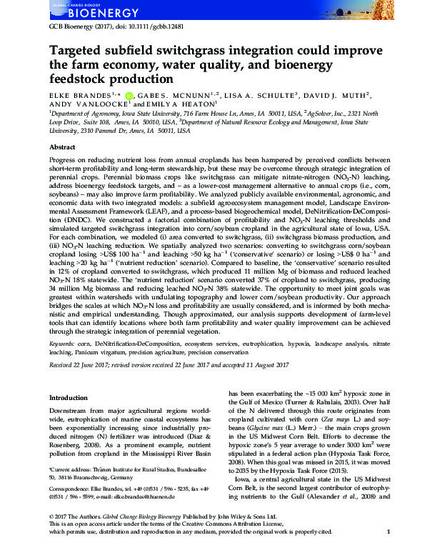
Progress on reducing nutrient loss from annual croplands has been hampered by perceived conflicts between short-term profitability and long-term stewardship, but these may be overcome through strategic integration of perennial crops. Perennial biomass crops like switchgrass can mitigate nitrate-nitrogen (NO3-N) leaching, address bioenergy feedstock targets, and – as a lower-cost management alternative to annual crops (i.e., corn, soybeans) – may also improve farm profitability. We analyzed publicly available environmental, agronomic, and economic data with two integrated models: a subfield agroecosystem management model, Landscape Environmental Assessment Framework (LEAF), and a process-based biogeochemical model, DeNitrification-DeComposition (DNDC). We constructed a factorial combination of profitability and NO3-N leaching thresholds and simulated targeted switchgrass integration into corn/soybean cropland in the agricultural state of Iowa, USA. For each combination, we modeled (i) area converted to switchgrass, (ii) switchgrass biomass production, and (iii) NO3-N leaching reduction. We spatially analyzed two scenarios: converting to switchgrass corn/soybean cropland losing >US$ 100 ha−1 and leaching >50 kg ha−1 (‘conservative’ scenario) or losing >US$ 0 ha−1 and leaching >20 kg ha−1 (‘nutrient reduction’ scenario). Compared to baseline, the ‘conservative’ scenario resulted in 12% of cropland converted to switchgrass, which produced 11 million Mg of biomass and reduced leached NO3-N 18% statewide. The ‘nutrient reduction’ scenario converted 37% of cropland to switchgrass, producing 34 million Mg biomass and reducing leached NO3-N 38% statewide. The opportunity to meet joint goals was greatest within watersheds with undulating topography and lower corn/soybean productivity. Our approach bridges the scales at which NO3-N loss and profitability are usually considered, and is informed by both mechanistic and empirical understanding. Though approximated, our analysis supports development of farm-level tools that can identify locations where both farm profitability and water quality improvement can be achieved through the strategic integration of perennial vegetation.
Available at: http://works.bepress.com/andy_vanloocke/25/

This article is published as Brandes, E., McNunn, G. S., Schulte, L. A., Muth, D. J., VanLoocke, A. and Heaton, E. A. (2017), Targeted subfield switchgrass integration could improve the farm economy, water quality, and bioenergy feedstock production. GCB Bioenergy. doi:10.1111/gcbb.12481. Posted with permission.